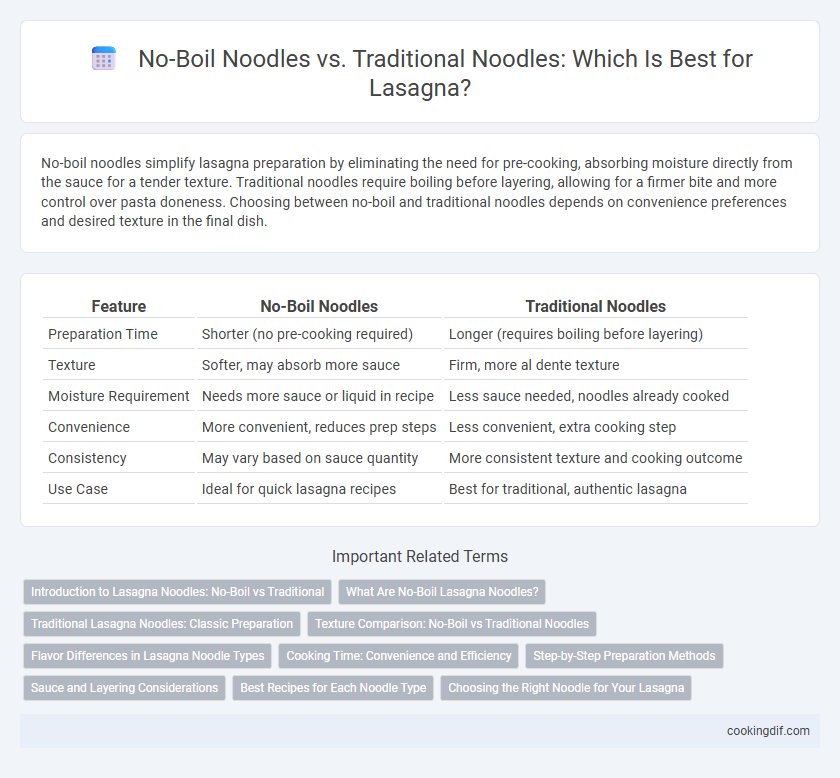No-boil noodles simplify lasagna preparation by eliminating the need for pre-cooking, absorbing moisture directly from the sauce for a tender texture. Traditional noodles require boiling before layering, allowing for a firmer bite and more control over pasta doneness. Choosing between no-boil and traditional noodles depends on convenience preferences and desired texture in the final dish.
Table of Comparison
| Feature | No-Boil Noodles | Traditional Noodles |
|---|---|---|
| Preparation Time | Shorter (no pre-cooking required) | Longer (requires boiling before layering) |
| Texture | Softer, may absorb more sauce | Firm, more al dente texture |
| Moisture Requirement | Needs more sauce or liquid in recipe | Less sauce needed, noodles already cooked |
| Convenience | More convenient, reduces prep steps | Less convenient, extra cooking step |
| Consistency | May vary based on sauce quantity | More consistent texture and cooking outcome |
| Use Case | Ideal for quick lasagna recipes | Best for traditional, authentic lasagna |
Introduction to Lasagna Noodles: No-Boil vs Traditional
No-boil lasagna noodles simplify preparation by eliminating the pre-cooking step, absorbing sauce during baking to achieve a tender texture. Traditional lasagna noodles require boiling before layering to ensure even cooking and prevent toughness in the final dish. Choosing between no-boil and traditional noodles impacts cooking time, texture, and sauce consistency in lasagna recipes.
What Are No-Boil Lasagna Noodles?
No-boil lasagna noodles are specially designed pasta sheets that soften during baking without pre-cooking, offering time-saving convenience compared to traditional noodles that require boiling before layering. These noodles typically have a thinner texture and are par-cooked to ensure proper hydration and even cooking when combined with sauce and cheese in the oven. Using no-boil noodles prevents overcooking and enhances the structural integrity of the lasagna, producing a tender yet firm dish with balanced moisture absorption.
Traditional Lasagna Noodles: Classic Preparation
Traditional lasagna noodles require boiling before layering, ensuring a tender yet firm texture that absorbs sauces evenly for a rich, cohesive dish. This classic preparation enhances flavor integration and prevents excess moisture from diluting the lasagna. Using traditional noodles maintains an authentic texture and structure preferred in time-tested Italian recipes.
Texture Comparison: No-Boil vs Traditional Noodles
No-boil noodles tend to absorb more sauce during baking, resulting in a softer, more tender texture compared to traditional noodles, which maintain a firmer bite due to pre-cooking. Traditional noodles provide a chewier consistency that many lasagna enthusiasts prefer for layered structure and mouthfeel. The choice between no-boil and traditional noodles largely affects the overall texture, with no-boil noodles creating a more cohesive, almost creamy consistency, while traditional noodles offer distinct, resilient layers.
Flavor Differences in Lasagna Noodle Types
No-boil noodles absorb sauce during baking, resulting in a softer texture that blends flavors more seamlessly, enhancing the overall taste of lasagna. Traditional noodles, pre-cooked before layering, maintain a firmer bite and distinct pasta flavor, offering a more pronounced wheat taste. Flavor intensity varies as no-boil noodles meld with other ingredients, while traditional noodles contribute a separate, sturdier pasta presence.
Cooking Time: Convenience and Efficiency
No-boil noodles reduce cooking time significantly by eliminating the need for pre-boiling, allowing them to soften directly in the sauce during baking. Traditional noodles require boiling before layering, which adds an extra step and increases overall preparation time. Using no-boil noodles enhances convenience and efficiency, making lasagna dishes quicker to assemble and bake.
Step-by-Step Preparation Methods
No-boil noodles simplify lasagna preparation by eliminating the pre-cooking step, requiring them to be layered directly with ample sauce to ensure proper hydration during baking. Traditional noodles necessitate boiling until al dente before assembly, allowing for more control over noodle texture but adding time to the process. Both methods depend on carefully balancing moisture and layering order to achieve a tender, cohesive lasagna.
Sauce and Layering Considerations
No-boil noodles absorb sauce during baking, which helps create a perfectly moist lasagna without pre-cooking, while traditional noodles require boiling to soften before layering. Using no-boil noodles allows sauces to penetrate each layer deeply, enhancing overall flavor integration and texture consistency. Traditional noodles need more precise layering to prevent dryness, as they can absorb sauce unevenly if not fully cooked or sufficiently sauced.
Best Recipes for Each Noodle Type
No-boil noodles simplify lasagna preparation by absorbing sauce during baking, making them ideal for lighter, faster recipes like vegetable or white sauce lasagna. Traditional noodles require pre-cooking and provide firmer texture, perfect for rich, meaty sauces and layered lasagna recipes that benefit from a heartier bite. Best recipes for no-boil noodles include creamy spinach and ricotta lasagna, while classic meat lasagna shines with traditional noodles.
Choosing the Right Noodle for Your Lasagna
No-boil noodles save time by softening directly in the sauce during baking, offering a convenient alternative without sacrificing texture or flavor. Traditional noodles require pre-cooking to achieve the perfect al dente bite, allowing more control over firmness and preventing over-softening. Selecting between no-boil and traditional noodles depends on your preference for preparation time versus precise texture control in your lasagna.
No-boil noodles vs Traditional noodles for pasta Infographic

 cookingdif.com
cookingdif.com